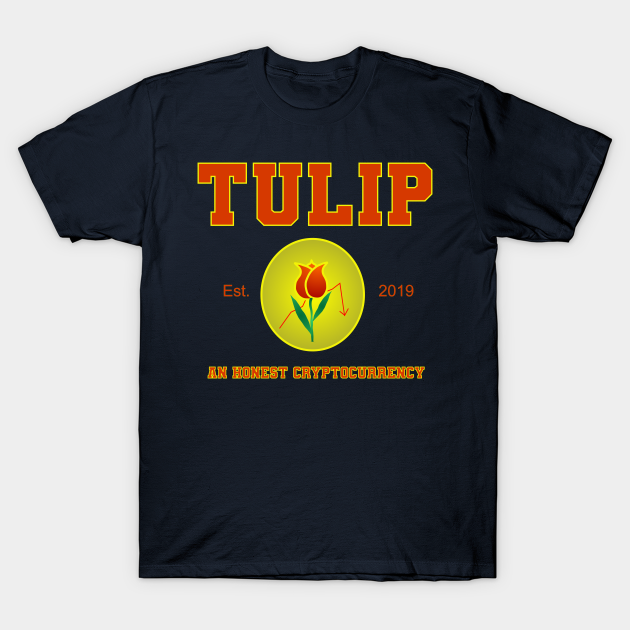Full Disclosure. I am still broke…and people who invested in cryptocurrencies have made a ton of money. That said. I said what I said and I still think this.
Besides, the shirt is hilarious and you should buy it.
Because explaining jokes makes them much funnier…and more searchable (haha)… information is provided below which should make this one much more clear and way funnier. Or not.
BE IRRATIONAL
BUY YOUR TULIP CRYPTO TEE HERE
Comparing cryptocurrency markets to irrational markets like the tulip boom provides insights into the nature of speculative bubbles and the behavior of investors. Both phenomena exhibit patterns of rapid price increases, intense speculation, and eventual dramatic declines.
Tulip Mania (1636-1637)
Overview:
- Location: Netherlands
- Commodity: Tulip bulbs
- Peak: Winter of 1636-1637
- Crash: February 1637
Key Characteristics:
- Speculation: Tulip bulbs became highly sought after, with prices rising exponentially. Tulips, especially rare varieties, were traded at extremely high prices.
- Market Behavior: Prices were driven not by intrinsic value but by speculation and the belief that prices would continue to rise. Many buyers had little interest in the tulips themselves and were purely speculating.
- Collapse: Prices plummeted in February 1637 as demand suddenly vanished, leaving many speculators with worthless bulbs.
Economic Impact:
- Widespread Financial Losses: The crash led to significant financial losses for individuals who had invested heavily in tulips.
- Limited Long-term Impact: While dramatic, the overall economic impact on the Dutch economy was relatively contained due to the relatively small size of the tulip market.
Cryptocurrency Market
Overview:
- Location: Global
- Commodity: Digital currencies (e.g., Bitcoin, Ethereum)
- Peak: Multiple peaks, notably in 2017 and late 2020-2021
- Volatility: Subject to dramatic price swings and periodic crashes
Key Characteristics:
- Speculation: Cryptocurrency markets are highly speculative, with many investors driven by the potential for high returns. Prices are influenced by market sentiment, media coverage, and social media.
- Market Behavior: Like tulip mania, the value of cryptocurrencies often exceeds their intrinsic utility, driven by speculation and hype. However, cryptocurrencies also have underlying technology (blockchain) that proponents argue has long-term value.
- Regulation and Security: Cryptocurrencies operate in a regulatory gray area in many regions, leading to concerns about security, fraud, and market manipulation.
Economic Impact:
- Widespread Participation: Unlike tulip mania, the cryptocurrency market is global, involving a diverse range of participants from individual investors to institutional entities.
- Technological Influence: The rise of cryptocurrencies has spurred innovation in financial technology, leading to developments in blockchain, smart contracts, and decentralized finance (DeFi).
- Potential for Systemic Risk: Given the growing integration of cryptocurrencies with traditional financial systems, there is potential for broader economic impacts in the event of a major crash.
Comparison
Speculative Nature:
- Tulip Mania: Driven entirely by speculative demand with no underlying utility beyond the aesthetic appeal of the tulips.
- Cryptocurrencies: Driven largely by speculation, but with a technological foundation that advocates argue has the potential for transformative applications.
Market Behavior:
- Tulip Mania: Rapid price increase followed by a sudden crash as market confidence evaporated.
- Cryptocurrencies: Subject to cycles of rapid appreciation and sharp declines, often triggered by external factors such as regulatory news or macroeconomic trends.
Investor Psychology:
- Tulip Mania: A classic bubble driven by the “greater fool” theory, where investors buy overpriced assets believing they can sell them at a higher price.
- Cryptocurrencies: Similar speculative behavior, but also influenced by a belief in the long-term potential of blockchain technology and decentralized systems.
Regulation and Security:
- Tulip Mania: Occurred in a largely unregulated market.
- Cryptocurrencies: Operating in a partially regulated environment, with ongoing debates about appropriate regulatory frameworks to ensure market integrity and investor protection.
Economic Impact:
- Tulip Mania: Limited long-term economic impact due to the small size of the market.
- Cryptocurrencies: Potential for significant economic impact given their growing market size and integration with traditional financial systems.
Conclusion
Both tulip mania and the cryptocurrency market exhibit characteristics of speculative bubbles, including rapid price increases, speculative fervor, and eventual corrections. However, cryptocurrencies differ in that they are underpinned by emerging technologies with potential long-term applications, whereas tulip mania was purely speculative. Understanding these dynamics can help investors and regulators navigate the complexities of modern financial markets.



